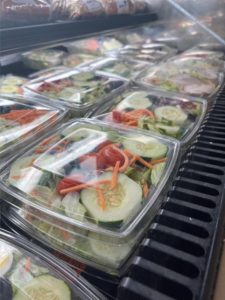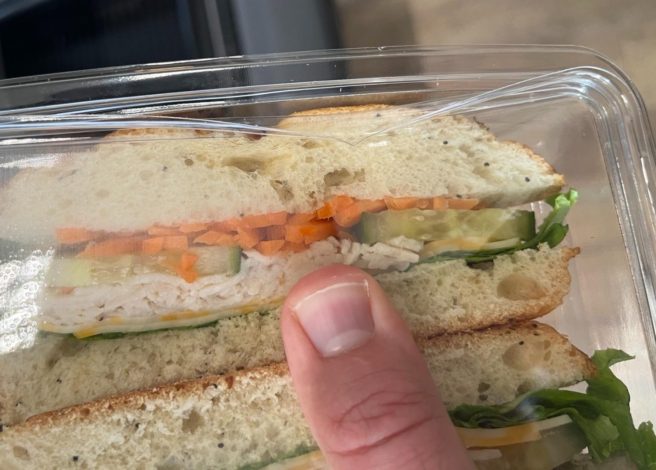At a Glance
- Gauge optimization protects your product and profits — thinner packaging may save cents but costs more through damage and lost trust.
- Thin gauges weaken tamper protection, making containers easy to open or reseal unnoticed.
- Proper gauge adds durability, stack strength, and true tamper protection that preserves revenue and reputation.
- Choose gauge based on product, display, and customer needs — not just price.
Tamper evidence. Tamper resistance. Consumer trust. Wasted product. That’s exactly what it’s costing you.
You know that sinking feeling when a customer walks up to the register with a container that’s clearly been opened? The one where the lid pops off a little too easily, the seal looks questionable, and you’re wondering if someone helped themselves to a few bites in aisle three?
That’s the hidden cost of cheap packaging showing itself in real time. Yikes!
At Inline Plastics, we’ve been providing fresh food businesses with packaging solutions for over half a century, and we know the importance of packaging that performs. We also know the pitfalls of when a customer has chosen packaging that just doesn’t work, and we want to share some tips with you.
In this article, we’ll break down what packaging gauge actually means, why optimizing gauge matters for tamper evidence, and how cutting corners on packaging costs you more in the long run through lost product, damaged reputation, and broken customer trust.
What Does Packaging Gauge Really Mean?
 Let’s start with the basics: “Gauge” refers to the thickness of plastic packaging material. Think of it like the difference between a flimsy plastic grocery bag and a sturdy container that actually protects your food. The higher the gauge number, the thicker and more durable the material.
Let’s start with the basics: “Gauge” refers to the thickness of plastic packaging material. Think of it like the difference between a flimsy plastic grocery bag and a sturdy container that actually protects your food. The higher the gauge number, the thicker and more durable the material.
We’re about to get a little technical, but stay with us. In the packaging world, gauge is typically measured in mils (one mil equals one-thousandth of an inch). A container with 20-mil walls is significantly sturdier than one with 10-mil walls. It’s not just about feeling more substantial in your hand — that extra thickness translates directly into performance.
Here’s where it gets interesting for your bottom line: Optimizing gauge isn’t just about feeling better. It protects better, stacks better, and most importantly, actually prevents tampering.
Why Is My Food Packaging So Easy to Open?
If you’ve ever wondered this about your grab-and-go items, you’re asking exactly the right question. And unfortunately, the answer usually comes down to one thing: Gauge (are you seeing a pattern here?).
Thinner packaging materials flex and bend more easily. Sure, it’s great for impromptu origami demonstrations, but terrible for literally everything else you need packaging to do.
We are not saying that thinner packaging is bad. There are plenty of applications for a thinner, more flexible plastic. However, that flexibility creates a serious vulnerability in your operation. When packaging is too thin, the tamper-evident features that are supposed to protect your product become about as useful as a bodyguard who faints at confrontation.
We recently examined packaging from a grab-and-go environment that illustrated this problem perfectly. The containers looked fine on the shelf. They had all the right features — a tamper-evident tear strip, supposedly secure closures, the works. But here’s the thing: With just a little pressure, you could pop the lid open without leaving any visible evidence of tampering.
The customer could slide the container back onto the shelf, and the next person to pick it up would have no idea it had been compromised. No broken seal. No obvious gaps. Nothing to indicate that someone had already helped themselves to that sandwich you worked tirelessly to perfect.
How Can You Tell if Packaging Has Been Tampered With?
This is where the rubber meets the road for food safety and customer trust. Tamper evidence isn’t just a nice feature — it’s essential for protecting your customers and your business.
Quality packaging with adequate gauge provides multiple tamper-evident indicators:
Visual cues: Containers with the correct gauge show obvious gaps or damage when someone tries to open them without authorization. The closure mechanism actually breaks or distorts rather than just flexing back into place. With containers that have “phoned-in” their gauge, you can squeeze the product and actually access the food inside (scary!).
Audible feedback: Properly gauged packaging often includes features that click or snap distinctly when first opened — a sign of strength and secure sealing. These mechanisms rely on adequate material thickness to function properly. When the gauge is too thin, those same features can lose their integrity — the “click” becomes weak or disappears altogether, creating uncertainty about whether the package is securely sealed.
Structural integrity: Thicker materials maintain their shape and closure tension. Once opened, they don’t seal back up convincingly. Thin materials, on the other hand, can be pried open and manipulated back into place (though, in all honesty, they may not look as nice as they did originally).
With thin packaging materials, these protective features essentially vanish. The plastic is so flexible that it can be manipulated without leaving evidence. That “secure” closure? It’s just a suggestion.
What Happens When Customers Don’t Trust Your Packaging?
 The cost of compromised packaging goes beyond just one tampered container. Trust is everything in the food business, and once it’s damaged, it’s incredibly difficult to rebuild.
The cost of compromised packaging goes beyond just one tampered container. Trust is everything in the food business, and once it’s damaged, it’s incredibly difficult to rebuild.
Consider what happens when a customer picks up a container and notices it opens too easily. Even if no one has actually tampered with it, that seed of doubt has been planted. They might put it back and choose a competitor’s product instead. Or worse, they might buy it, have concerns later, and never return to your business.
Then there’s the liability issue. If someone tampers with your product and another customer consumes it, you could face potential health department complaints, legal exposure, and reputational damage that might take years to overcome. The few cents you saved per container suddenly look like a catastrophically expensive decision.
Is Thinner Packaging Really Less Expensive?
On the invoice? Sure. Thin-material packaging typically costs less per unit. That’s the appeal, and it’s why so many businesses make this choice without thinking through the full implications.
But let’s do some real math on a hypothetical scenario:
If you save two cents per container by choosing packaging made with a gauge that’s too light for the design, those savings can disappear quickly. Let’s say you lose just 2% of your product to tampering, damage, or returns — on a $3 item, that’s a six-cent loss per unit. And that’s being conservative. Once you factor in the less tangible (but equally important) costs — customers who don’t come back, damage to your brand’s reputation, and the time your staff spends managing complaints — that “savings” ends up costing you much more.
Quality packaging with proper material thickness costs slightly more upfront but provides:
- Legitimate tamper evidence that protects both product and reputation
- Better stackability that reduces damage during transport and storage
- Enhanced durability that prevents leaks and breaks
- Customer confidence that translates to repeat business
- Your peace of mind that you have done everything in your power to maximize food safety with packaging — priceless!
The math isn’t complicated. Protecting your product and your customers’ trust is worth a couple of extra pennies per container (and a few more for a larger one).
How Do You Optimize Packaging Gauge for Your Business?
 Start by evaluating your actual needs rather than just comparing prices. Ask yourself:
Start by evaluating your actual needs rather than just comparing prices. Ask yourself:
What are you packaging? Heavier or liquid-dense foods need more structural support. Delicate items need protection from crushing.
Where will it be displayed? Grab-and-go environments have different requirements than behind-counter service. Self-service areas demand better tamper evidence, so you’re going to want to make sure the gauge of your packaging isn’t too thin for those features to work.
Who’s your customer? Premium products deserve premium packaging. If you’re positioning your food as high-quality, the container should reflect that.
What’s your liability tolerance? Hint: In today’s food safety environment, the answer should be “very low.”
Work with packaging suppliers who can explain gauge specifications in terms that matter to your operation. Ask specifically about optimizing the gauge for your product type and service model. Don’t just accept “This is what everyone uses” as an answer (rude, much?). Not everyone faces the same challenges you do.
Gauge Your Options
Optimizing material thickness isn’t an expense. It’s an investment in your business, your customers’ safety, and your peace of mind. When you choose packaging with the right gauge for your needs — one that actually protects your product and provides legitimate tamper evidence — you’re making a statement about the quality of your operation.
The next time you’re reviewing packaging options and see a “cheaper” alternative, remember that grab-and-go container that pops open without leaving a trace. Fully test it and envision what it will face through the supply chain. Then ask yourself what that’s really costing you.
Your customers are trusting you with their food. Your packaging should honor that trust, not undermine it.
Are you interested in learning more about plastic packaging solutions? Visit the Inline Plastics Learning Center today!

